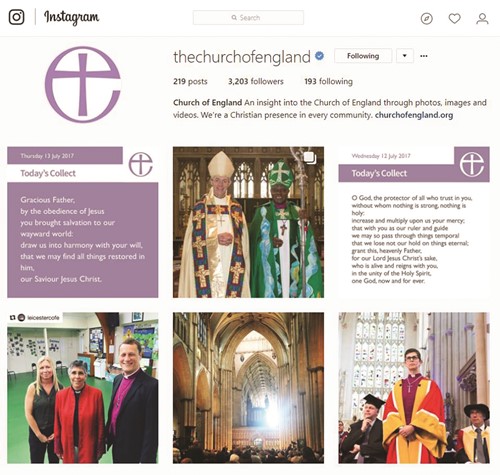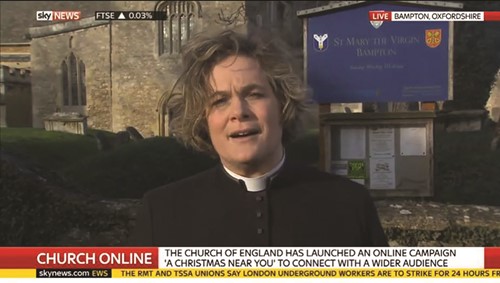
SPREADING THE MESSAGE
The Church of England has long existed to support Christianity across the UK. Now, its fresh approach to digital communications is helping it spread its message farther than ever before. Amy Sandys reports on the church’s initiatives
Challenge: An institution that recently celebrated its 500th birthday, the Church of England has been at the heart of the nation’s civic, social and religious life since its formation in 1534. While first and foremost an institution formed to facilitate prayer, worship and the celebration of the Christian faith, the Church of England and its facilities enjoy a plethora of functions. From weddings, to funerals, to christenings, to parent and toddler groups, to polling stations and social group meeting facilities, the groups using the church are varied and ever-growing.
Yet, says Adrian Harris, head of digital communications at the Church of England, communicating the message of openness through faith and devotion, to the church community and its wider, potential target audience, has been a struggle. “We’ve got so much data of about 16,500 churches across the country, and there’s a lot of church halls if you think about all the work that goes on,” says Harris. “But actually, how can we do more with the data and share with the communities across the country what goes on locally in your church? People aren’t aware of not only what goes on on a Sunday, but also what happens throughout the week where churches are living out Christian life in the local community.”
The uptake in digital communications across the church’s wide demographic spurred Harris and his digital team to pursue a way to “bring other people to faith, but also to grow people in their faith,” says Harris. “It’s about how we generate content, lots of good original and compelling content, and how we use social media to emphasise the work we do.”
Using the church’s resources to craft a message of faith and community from the inside out, Harris and his digital team developed ‘Church of England Digital Labs.’ A user-led, hackathon style project whereby church members can come together and pitch creative, tech-driven solutions to the communications issues within its midst, it aims to address the church’s challenges while consolidating creativity within the Christian community.

Strategy: Given the historically strong connection the church has enjoyed with its members, an obvious solution to the problem of lack of awareness about the activities of the Church of England was to tap into the vast amounts of creative talent hidden within its realms. Creating the Digital Labs project saw Harris directly approach those who recognise the church as a part of their life – marrying a forward-looking digital approach with the religious commitment of the historic institution. “There’s a huge Christian creative and tech community out there, of people who both work in industry and go to church,” says Harris. “What we’re doing is bringing that group of people together, people with real expertise in industry or advertising or creative agencies, who are coders, technicians, and laying out the challenges.”
This, says Harris, perfectly reflects the church’s wider mission, “All of our work is about renewal and reform, it’s about growing the church and gathering people together.” Harris also emphasises the solutions-led approach Digital Labs will take, another way the Church of England will differentiate itself from other, more typical, digital-led organisations. It also reflects the church’s inherent sense of grassroots organisation and reliance on its wider community for success.
“Unlike a lot of hackathons, where there’s lots of ideas and then they disappear, we’re going to take a couple of the best ideas and trial it with some of our churches across the country,” says Harris. “If it goes really well we’ll roll them out nationally. And that’s so exciting – it’s working with people on really good ideas, turning them into something that is deliverable and then trialling it.”


Results: For Harris and his digital team, the results of the shift to digital have been remarkable. The Church of England’s Digital Lab project will properly begin in February 2018, but already the church has had dozens of technologically- or creatively-minded individuals register their interest. Followers on the Church of England’s Instagram account have tripled in the last six months, with an intriguing mixture of content including prayers, images and video clips of faith in action, appealing to a younger, image-led generation – as well as older demographics who have leapfrogged straight into the use of iPads and smartphones.
As for the Digital Labs, Harris and his team can’t wait to see the results. “It’s going to be fascinating because the church hasn’t done anything like this before, and I really like the humility of the message of, ‘Let’s get the best and the brightest in the room, let’s come up with a couple of cool ideas and trial it with our community.’” And, says Harris, the Digital Labs event as well as the church’s extended social media coverage is symptomatic of a wider paradigmatic shift currently occurring in the church community. Harris says, “There’s a lot of excitement about all this work because it’s increasingly where the audience is. There’s such a world pivoting to social and digital and there’s a lot of potential for the church in that space. It’s about opening the doors up in the most strategic way – a way that really brings people, and grows people, into their Christian faith.”
The days of hymn sheets and church hall notice boards might not be completely over, but the digital generation is demanding something more from its church community.




